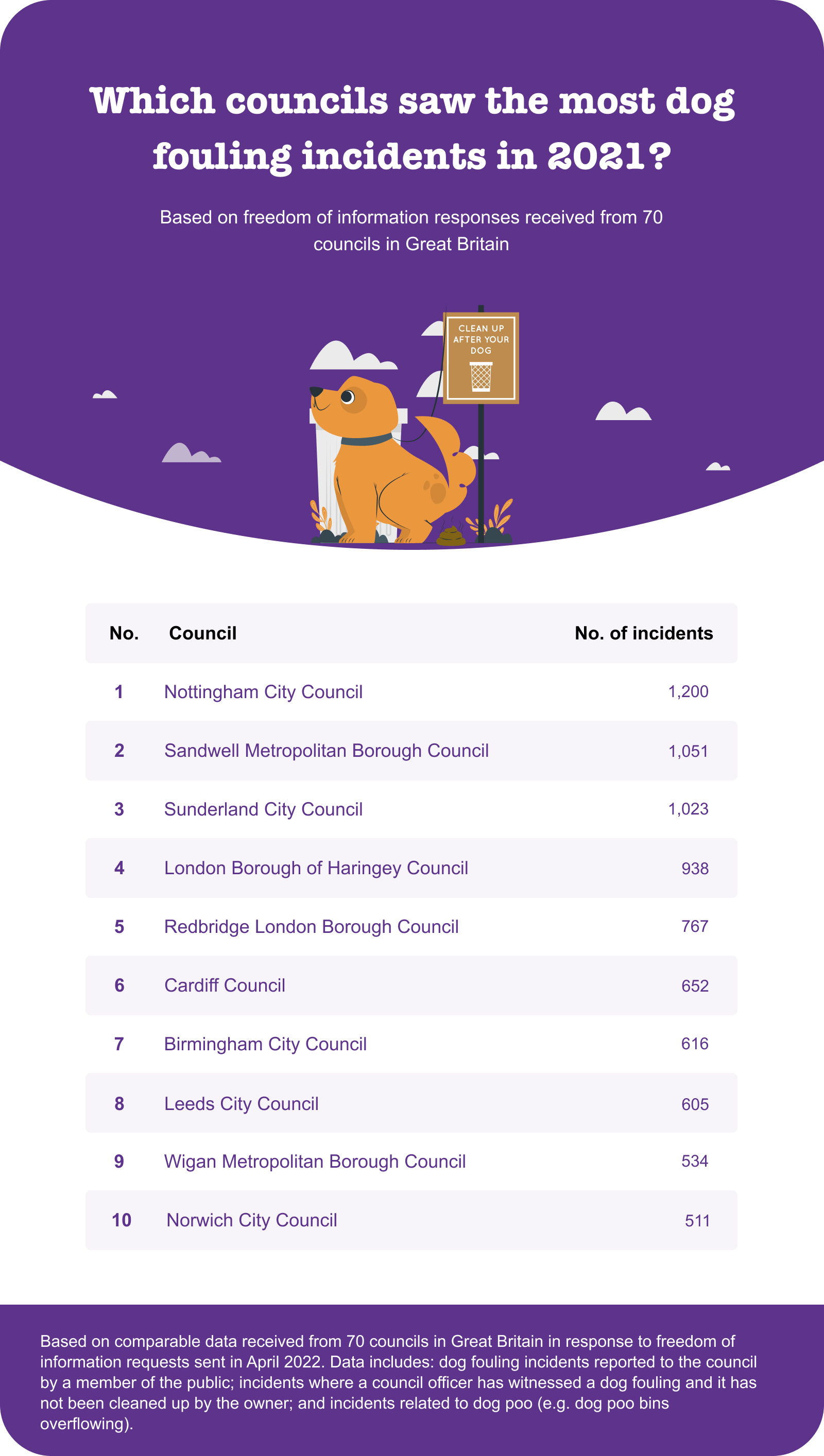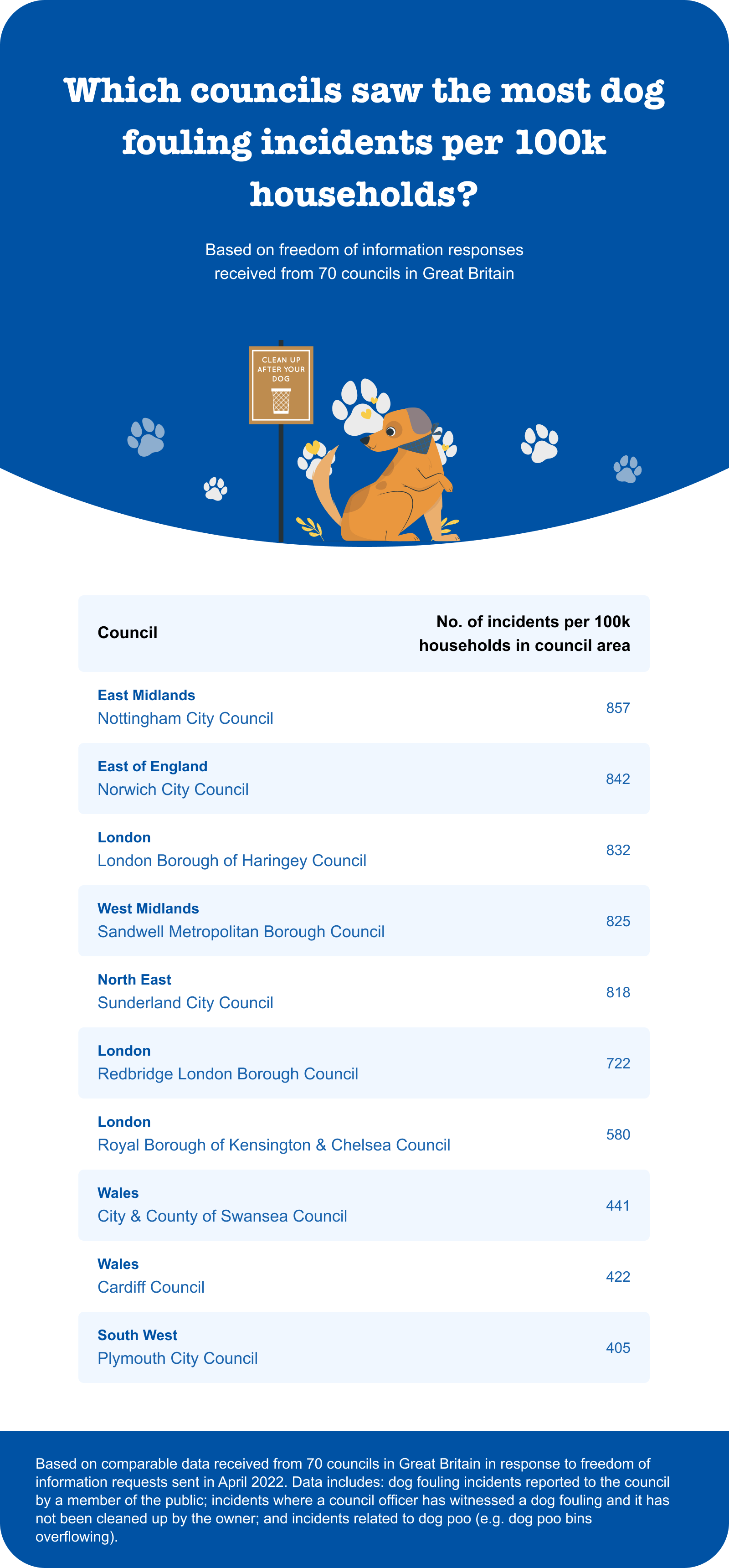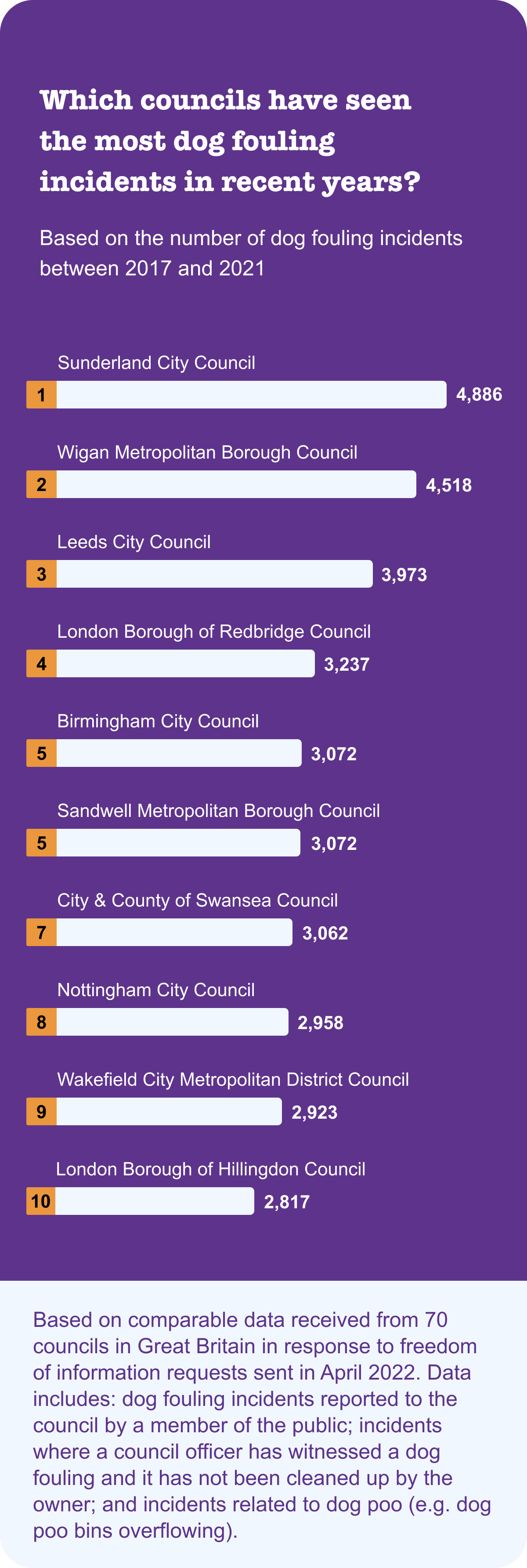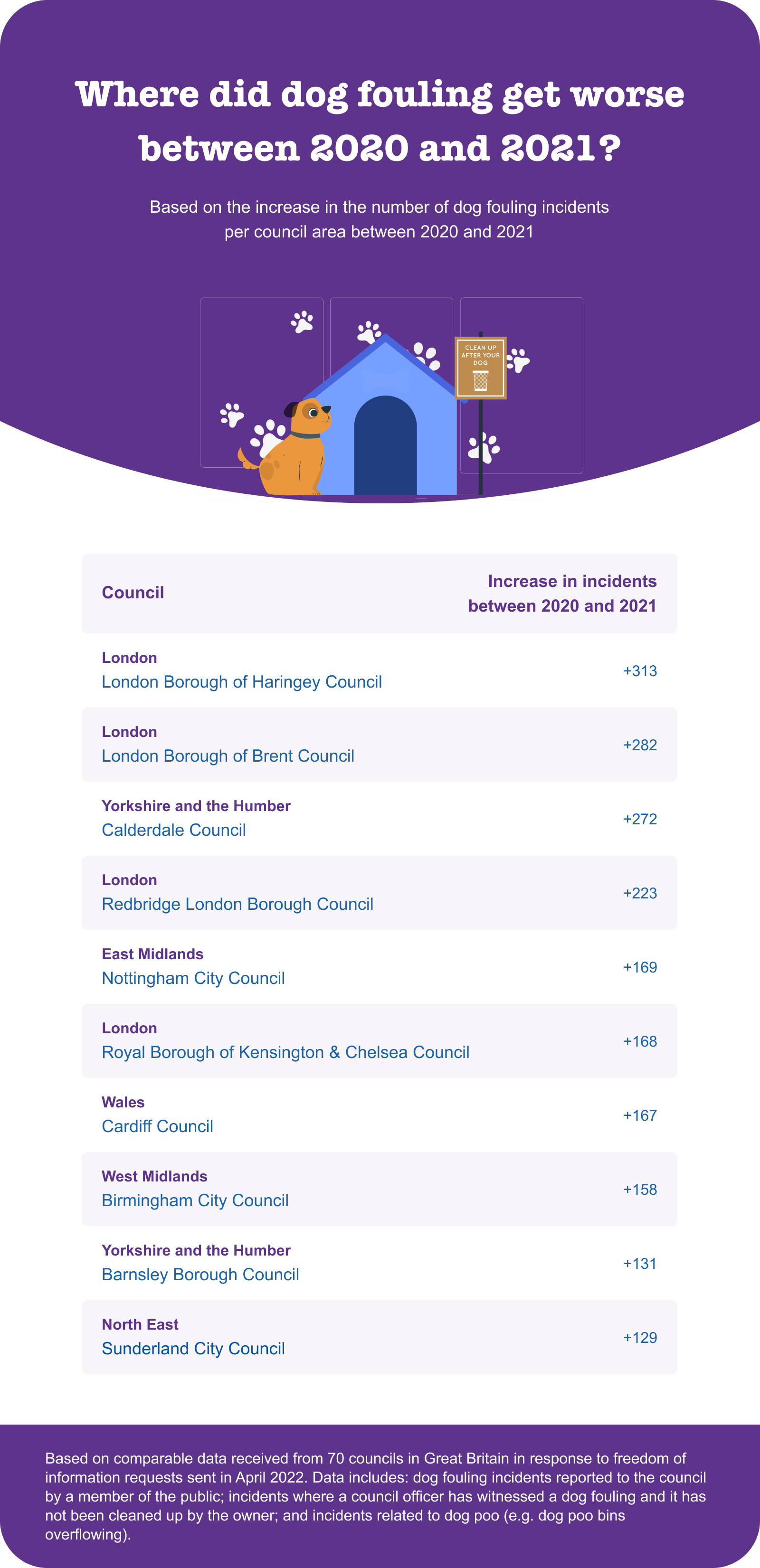While it’s not a pleasant task, picking up your dog’s poo is an important part of being a responsible dog owner and is legally required. Dogs in the UK produce over 3,000 tonnes of poo every day, and when left on the ground, dog poo can pose serious hazards to other dogs, the environment, wildlife, and humans.
The canine parvovirus is one example of a potentially deadly disease that can be passed on through dog poo and survive in the ground for many years; luckily this is a routine vaccination, so provided your dog’s jabs are up to date the risk of them catching it is minimal. While rare, humans can also pick up infections like toxocariasis from dog poo that can lead to serious health problems. Moreover, one study discovered that dog poo can threaten the biodiversity of nature reserves.
With this in mind, we wanted to explore the scale of Great Britain’s dog fouling problem and discover the council areas in which the issue is most prevalent and on the increase. We sent off freedom of information requests to 101 councils in England, Scotland, and Wales to find out, and spoke to the founder of the national anti-littering campaign Clean Up Britain to help put our findings into context.
Which councils saw the most dog fouling incidents in 2021?
We asked 101 councils around Great Britain to tell us how many complaints they had received about dog fouling in 2021, and 70 replied to us with comparable data.
The figures we received include dog fouling incidents reported to the council by a member of the public, incidents where a council officer has witnessed a dog fouling
and it has not been cleaned up by the owner, and other incidents related to dog poo (for example, dog poo bins overflowing).
In the Nottingham City Council area, 1,200 incidents related to dog poo were reported in 2021 – that’s more than anywhere else in England, Scotland, and Wales. Sandwell Metropolitan Borough Council in the West Midlands comes second in our ranking with 1,051 incidents in 2021.


Which councils saw the most dog fouling incidents per 100k households?
Per 100k households in the area, Nottingham City Council saw the most dog fouling incidents (857) in 2021. Norwich City Council (842) and the London Borough of Haringey (832) come in second and third place in this ranking respectively.


Which councils have seen the most dog fouling incidents in recent years?
We wanted to find out which councils have seen the most dog fouling incidents in recent years. Between 2017 and 2021, there were 4,886 incidents in the Sunderland City Council area. That’s more than any other council area in Great Britain. Wigan takes the next spot in our ranking with 4,518 incidents, followed by Leeds (3,973).


Which regions have seen the most dog fouling incidents in recent years?
When we grouped council responses into British regions, we found that London counted the most dog fouling incidents (17,895) between 2017 and 2021. The combined councils in the North West region reported 15,153 incidents in the same time frame.


Where did dog fouling get worse between 2020 and 2021?
Overall, we found that there was a nationwide 8.3% increase in dog fouling incidents between 2020 and 2021. On a local level, the biggest increase in the number of incidents (+313) was seen in the London Borough of Haringey council area. The London Borough of Brent saw the next biggest increase (+282), followed by Calderdale (+272) in Yorkshire and the Humber.


We spoke to John Read, the founder of the anti-littering campaign Clean Up Britain, to find out more about the effect of dog fouling on public spaces and what more can be done to stop it.
1. How big a threat is dog fouling to public spaces in Britain, the environment, and wildlife? Is it a danger to humans?
Dog faeces contains toxins and things that are not good for humans, particularly babies and young children. From that point of view, dog fouling is a danger and an environmental hygiene issue – and it's also an issue of nobody wanting to step in that dog mess. Councils have the ability to fine people up to £1,000 for dog fouling, and they should use that as often as they can to penalise dog owners who are not doing the right thing in clearing up their dog’s mess.
2. Are there currently enough deterrent measures (e.g. fixed penalty notices) against dog fouling in the UK? Should the police and/or local authorities be doing more to stop it happening, and what could they do?
They could issue fines to more people and make an example of dog fouling offenders, and publicise it so people know there’s a realistic chance of being caught. We all need to behave responsibly and sensibly, and with respect to each other and the environment. Dog fouling is a bit like littering in that it is a crime against society. That isn’t necessarily at the moment a legally recognised concept, but it should be. Like littering, dog fouling happens in public spaces; everyone wants to use the local park, and most people want them to be picturesque and pleasant places to be, but when dog owners leave their dog’s excrement there, they are committing a crime against not only one person but everyone who uses the park. This is why we call them crimes against society. I believe the £1,000 fines need to be applied in a more serious, sustained manner.
3. According to our analysis, between 2020 and 2021, there was a nationwide 8.3% rise in dog fouling incidents. Why do you think this number has risen? Is the public becoming more complacent about picking up after their dogs?
That may have had something to do with the amount of people who got new pets in the pandemic, but weren’t necessarily used to having pets. Unfortunately, you do see it now with cats and dogs – people suddenly realise that pets need to be looked after properly, and that they aren’t playthings. They are live entities like human beings and they have requirements, like eating, drinking, and going to the toilet. A lot of new pet owners might not fully realise these kinds of responsibilities that come with having a dog. For the increased number of people who got dogs during lockdown, maybe they took their dog to the park as part of the only exercise available to them and then let them go to the toilet freely in the park.
4. Petplan works with EcoGreenCommunities to provide free compostable poo bags at 100 dog waste stations around the country. Is there anything that an individual can do in their local area to encourage more people to clear up after their dogs?
The obvious thing someone can do if they see a dog owner not clearing up after their dogs is to say, “excuse me, I think you’ve left something behind”. Obviously, that can be done in a very polite and respectful way. That’s the sort of thing you can do when you witness someone littering, as well. Usually, you’ll get two responses: someone can be antisocial, or they will become very embarrassed and sheepish because they know they’re in the wrong and they’ve been caught out.
With littering – and dog fouling is a form of littering – we need people to be more respectful of each other and the environment, and have pride in the area they live. Nowadays, one problem we have is that people aren’t respectful to each other – and dog fouling is symptomatic of that. It’s antisocial, selfish, and irresponsible to leave behind your dog’s mess and be happy enough to let other people walk into it. Unfortunately, people who do that need to be fined. They’re not living to the standards that a civilised society should maintain and aspire to.
Notes on methodology
We sent freedom of information requests in April 2022 to 101 councils in Great Britain to find out about the scale of dog fouling incidents between 2017 and 2021 in each council area. We received comparable data from 70 councils and only these councils are included in our analysis.
Our freedom of information request asked councils to supply figures on dog fouling incidents that were reported to the council. Depending on the council, figures received might include: incidents reported to the council by a member of the public; incidents where a council officer has witnessed a dog fouling and it has not been cleaned up by the owner; and incidents related to dog poo (for example, dog poo bins overflowing).
The number of households per local council area was sourced from the Office for National Statistics and uses 2019 figures.
Our analysis was completed in June 2022.









